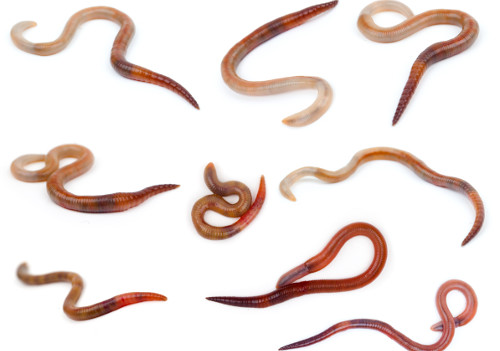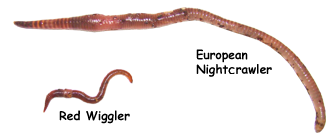Red Wiggler Worms - Perfect for Vermicomposting and Soil Enrichment
Red Wiggler Worms - Perfect for Vermicomposting and Soil Enrichment
Blog Article
Making Best Use Of the Perks of Red Wiggler Worms: A Comprehensive Guidebook for Home Gardeners and Urban Farmers
In the world of lasting horticulture techniques, red wiggler worms stand as unrecognized heroes, silently transforming organic waste right into nutrient-rich spreadings that can function wonders for soil health. By checking out the intricacies of how to effectively care for and maximize the benefits of red wiggler worms, people can unlock a wide range of possibilities for enhancing the sustainability and performance of their gardening endeavors.
Recognizing Red Wiggler Worms
Red Wiggler worms, renowned for their reliable composting capacities, are a species of earthworms widely used in vermiculture methods. These worms, clinically understood as Eisenia fetida, flourish in rotting organic product, making them suitable prospects for composting.
One secret quality of Red Wiggler worms is their reproductive price. These hermaphroditic animals possess both male and female reproductive body organs, permitting them to reproduce quickly under beneficial problems. A fully grown Red Wiggler can create several spawn in a short period, guaranteeing a steady populace within a composting system.

Establishing a Worm Container
When establishing a worm container for vermiculture functions, appropriate preparation and focus to information are necessary for producing a conducive setting for Red Wiggler worms. Begin by choosing an appropriate container for your worm bin.

Place the worm container in a cool, dark location away from direct sunlight and extreme temperatures. By complying with these steps, you can establish up a growing worm bin that will effectively refine natural waste right into nutrient-rich vermicompost for your yard.
Feeding and Preserving Worms
Ensuring a nourishing and balanced diet regimen is crucial for the health and productivity of Red Wiggler worms in a vermiculture system. Red Wigglers are starved eaters, qualified of eating their very own body weight in raw material daily. To maintain a growing worm population, it is important to offer them with a selection of food scraps such as fruit and vegetable peels, coffee premises, tea bags, and smashed eggshells. It is vital to avoid feeding them citrus fruits, onions, garlic, milk items, meat, and oily foods as these can be unsafe to the worms or cause undesirable odors in the container.
Appropriate wetness levels are also crucial for the wellness of Red Wiggler worms. By vigilantly checking their diet, moisture, and ecological problems, home gardeners and urban farmers can sustain a healthy and balanced and effective Red Wiggler worm population for composting purposes.
Collecting Worm Spreadings
To effectively extract nutrient-rich worm spreadings from the vermicompost, a systematic harvesting procedure is crucial for maximizing the composting advantages. The first action in gathering worm castings is to encourage the worms to move to one side of the bin.
After the spreadings have been collected, it is essential to separate any type of continuing to be worms from the visit the website castings to stay clear of harming them during storage space or application. One efficient approach is to produce conical stacks of spreadings under brilliant light. Worms will intuitively move away from the light, enabling easy splitting up and elimination.
Lastly, the gathered worm spreadings should be kept in a trendy, dark, and dry location to keep their quality and efficiency as a nutrient-rich dirt modification. By following these steps, home gardeners and metropolitan farmers can optimize the advantages of red wiggler worms in their vermicomposting systems.
Utilizing Worm Castings in Gardening
The consolidation of nutrient-rich worm spreadings right into yard dirt can considerably improve plant development and general dirt wellness. Worm castings, also understood as vermicast, are a natural fertilizer created by red wiggler worms as they damage down natural issue. These spreadings are rich in necessary nutrients like nitrogen, phosphorus, potassium, and beneficial microbes that promote plant development and improve soil structure.
When utilizing worm castings in gardening, it is important to mix them completely into the soil or use them as a navigate to this site top clothing around plants. The slow-release nature of worm spreadings makes certain a steady supply of nutrients to plants over time, reducing the threat of nutrient leaching and advertising lasting click for source dirt fertility. Furthermore, worm spreadings help improve dirt oygenation, water retention, and microbial activity, producing a healthy and balanced setting for plant origins to grow.

Verdict
In final thought, the usage of red wiggler worms in home gardening and urban farming can considerably benefit dirt health and plant development. By recognizing exactly how to set up and preserve a worm bin, feed the worms properly, and harvest their nutrient-rich spreadings, garden enthusiasts can optimize the benefits of these earthworms.
In the realm of lasting horticulture methods, red wiggler worms stand as unsung heroes, silently transforming organic waste right into nutrient-rich castings that can work marvels for soil wellness.When developing a worm bin for vermiculture purposes, correct preparation and attention to information are necessary for producing a conducive environment for Red Wiggler worms. The very first step in collecting worm castings is to urge the worms to migrate to one side of the bin. Worm spreadings, additionally known as vermicast, are an all-natural plant food produced by red wiggler worms as they damage down natural matter. By recognizing how to establish up and maintain a worm container, feed the worms correctly, and collect their nutrient-rich castings, garden enthusiasts can take full advantage of the benefits of these earthworms.
Report this page